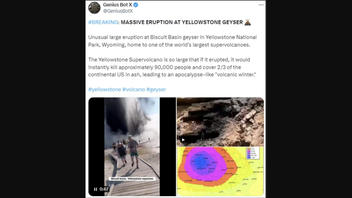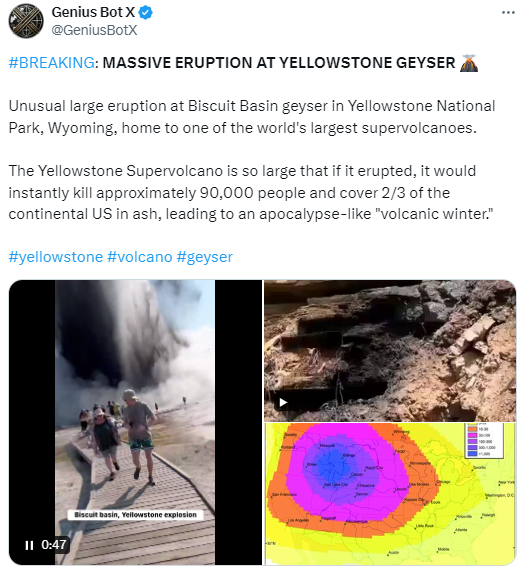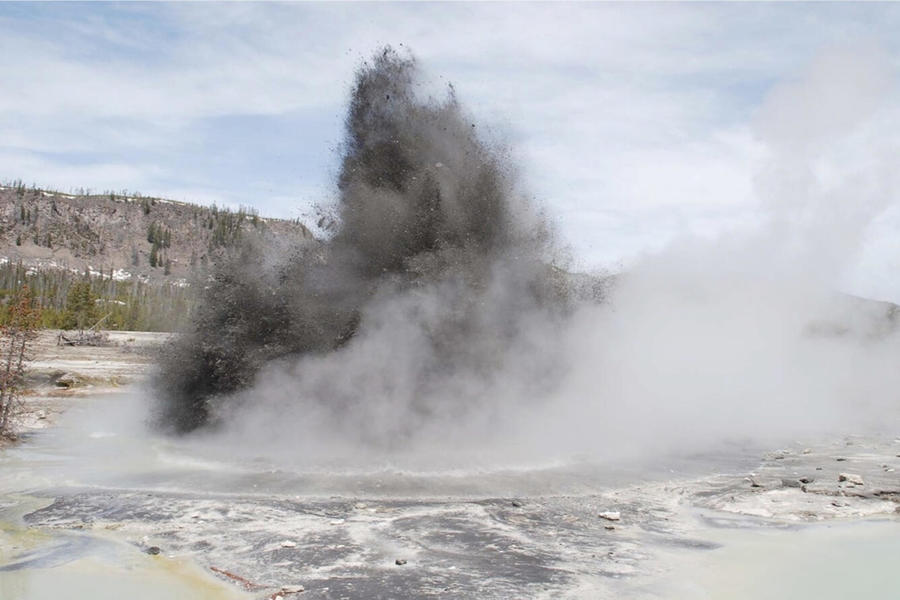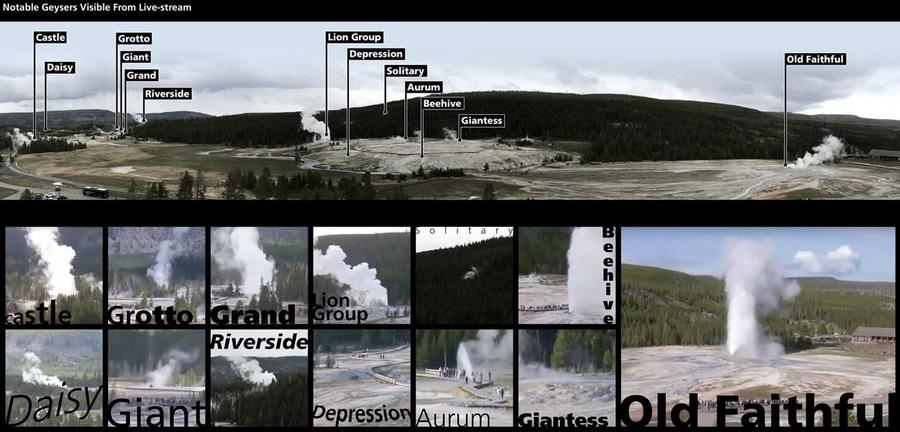STORY UPDATED: check for updates below.

Was a hydrothermal explosion on July 23, 2024, at Yellowstone National Park's Biscuit Basin considered "unusual" by experts, as a post on X claimed? No, that's not true: Officials with the U.S. Geological Service said the "small hydrothermal explosion" was considered "normal." The Yellowstone Volcano Observatory and Yellowstone National Park issued a joint statement stating that monitoring data showed "no changes in the Yellowstone region."
The claim originated in a post on X on July 23, 2024 (archived here), with a caption that read:
#BREAKING: MASSIVE ERUPTION AT YELLOWSTONE GEYSER 🌋
Unusual large eruption at Biscuit Basin geyser in Yellowstone National Park, Wyoming, home to one of the world's largest supervolcanoes.
The Yellowstone Supervolcano is so large that if it erupted, it would instantly kill approximately 90,000 people and cover 2/3 of the continental US in ash, leading to an apocalypse-like 'volcanic winter.'
#yellowstone #volcano #geyser
Here is how the post appeared at the time of writing:
(Source: X screenshot taken Wed July 24 09:43:00 2024 UTC)
The post implies that the eruption at Yellowstone National Park's Biscuit Basin in July 2024 was "unusual" and "large," while park and geological officials have publicly stated the opposite -- that this hydrothermal event was "normal."
In a post on X on July 23, 2024 (archived here), the U.S. Geological Survey (USGS) Volcano Hazards Program confirmed that the eruption was considered a "small hydrothermal explosion."
YVO Yellowstone GREEN/NORMAL - Small hydrothermal explosion in Biscuit Basin; volcanic activity remains at background https://t.co/ZkcEIC4toy
-- USGS Volcanoes🌋 (@USGSVolcanoes) July 23, 2024
On the same day, the USGS Yellowstone Volcano Observatory (YVO) and Yellowstone National Park published a joint statement (archived here) that further confirmed hydrothermal explosions like the one seen at Biscuit Basin are "relatively common in Yellowstone." The statement notes that the eruption at Biscuit Basin does not indicate any underlying "Supervolcano" activity, as the post on X implies:
Monitoring data show no changes in the Yellowstone region. Today's explosion does not reflect activity within volcanic system, which remains at normal background levels of activity. Hydrothermal explosions like that of today are not a sign of impending volcanic eruptions, and they are not caused by magma rising towards the surface.
Similarly, a news release published by the park on July 23, 2024 (archived here), confirmed that no injuries were reported and that the "explosion does not reflect a change in the volcanic system, which remains at normal background levels of activity."
Michael Poland (archived here), YVO scientist-in-charge, told Lead Stories that the explosion is not a sign of potential volcanic activity. In an email received on July 25, 2024, he wrote that the explosion was caused by changes in Black Diamond Pool's "plumbing system," adding that:
If this had been driven by changes in the magmatic system, we would have seen far different forms of activity -- numerous earthquakes (including felt ones), dramatic ground deformation, changes in thermal and gas emissions, and anomalous hydrothermal activity far beyond this single set of features. Obviously, none of that has happened.Point being, this eruption has nothing to do with volcanic activity other than that cooling magma located miles beneath the surface provides the heat needed to sustain Yellowstone's geysers and hot springs. But changes in the shallow hot-water plumbing system are independent of anything happening at depth. Changes are also frequent -- it is a very dynamic system.Eruptions of this size are not unprecedented. Indeed, in the geologic history of the volcano, this one was relatively small. Some craters left by steam explosions are hundreds of feet across, and one -- Mary Bay, on the north side of Yellowstone Lake -- is 1.5 miles across! Smaller ones happen perhaps a couple of times a year somewhere in Yellowstone, but often in the backcountry, where they may go unnoticed.
Park officials have recorded other similarly sized explosions, including one at Porkchop Geyser (archived here) in Norris Geyser Basin in 1989 and another at Norris Geyser Basin (archived here) on April 15, 2024.
Park records (archived here) also indicate that Biscuit Basin (archived here) saw a similar eruption on May 17, 2009, when a nearby location called Wall Pool "surged, then erupted, expelling foot-sized ejecta," which the photograph taken at the time (below) show. The 2009 eruption was reported as having emitted a "sensation of heat... which lasted for an estimated 10 to 15 seconds."
Source: USGS
Geyser Times, a nonprofit organization that tracks geyser eruptions, recorded the July 2024 eruption at Black Diamond Geyser in Biscuit Basin, dubbing it Eruption 1470357 (archived here).
The park notes (archived here) that Black Diamond Pool, where Black Diamond Geyser is located in Biscuit Basin, erupted "black murky water after an earthquake in July 2006," eruptions have since been recorded in the following years. At the time of writing, Geyser Times records (archived here) also showed 63 other eruptions at the same location dating back to 2006, occurring an average of about 107 days apart.
More than 10,000 hydrothermal features, including more than 500 geysers (archived here), are found within the boundaries of Yellowstone National Park -- more than anywhere else on Earth. However, what geologists consider a "large" eruption occurs roughly every 700 years, which the USGS says is "not a particularly likely event" (archived here).
The National Park Service (NPS) writes (archived here) that geysers are the most well-known geothermal feature:
Each geyser has unique characteristics due to complex internal plumbing. Generally, geysers require that large amounts of groundwater fill underground cavities in an area of volcanic activity. The water in these deep cavities is heated by nearby magma. Suddenly, some of the water flashes into steam and expands rapidly. The overlying water column is forced violently from the vent in an explosion of hot water and steam. This cycle can be repeated regularly.
Eruptions in Yellowstone National Park are so frequent that the park service even has a live stream (archived here) of Old Faithful and other notable geysers available online. The below NPS compilation shows 13 notable geysers visible in the live-stream webcam.
(Source: Yellowstone National Park)
Lead Stories has debunked other claims involving Yellowstone National Park, including that 100 earthquakes that supposedly "hit" the park in December 2023 may lead to an eruption, the false claim that the Yellowstone "Supervolcano" eruption was imminent, and that colonizers reduced North American bison numbers until there were only 27 left.
Updates:
-
2024-07-25T21:41:12Z 2024-07-25T21:41:12Z Adds information from scientist Michael Poland of the Yellowstone Volcano Observatory.

















